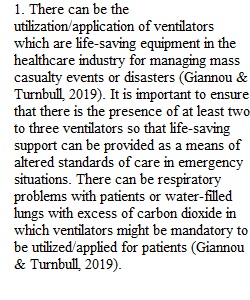


Q In the 2009 Letter Report, the Institute of Medicine (IOM) defined the level of health and medical care capable of being delivered during a catastrophic event as “crisis standards of care”: “Crisis standards of care” is defined as a substantial change in usual healthcare operations and the level of care it is possible to deliver, which is made necessary by a pervasive (e.g., pandemic influenza) or catastrophic (e.g., earthquake, hurricane) disaster. This change in the level of care delivered is justified by specific circumstances and is formally declared by a state government, in recognition that crisis operations will be in effect for a sustained period. The formal declaration that crisis standards of care are in operation enables specific legal/regulatory powers and protections for healthcare providers in the necessary tasks of allocating and using scarce medical resources and implementing alternate care facility operations. Discuss the following: 1. What are some examples of altered standards of care during mass casualty events or disasters? 2. What are some considerations or ethical concerns with the altered or crisis standards of care? ************************************************************************************************************************************* ALL FORUMS Initial Response: Initial responses should be no less than 450 words in length not including your reference(s) and supported by at least two references (aside from the textbook). Initial responses are due no later than 11:55 p.m. ET on Wednesday, Day 3 of each week. This allows time for other students to respond to your initial response. Please be aware that just “cutting and pasting” sections of articles (in lieu of writing an original initial post) is not acceptable and will negatively impact your grade. Peer Responses: Students are required to respond to at least two (2) other student’s initial postings (and the instructor) with significant comments that have substance. Peer responses are due no later than 11:55 p.m. ET on Sunday, Day 7 of each week. All peer responses must be substantial and significant and should be no less than 200 words in length not including your reference(s) and supported by at least one reference (aside from the textbook). If possible, one of the responses to another’s work should be from an opposing viewpoint. Your response to your peers work should be engaging and informative with good substance (just stating “I agree…” is not acceptable). Your responses should contribute in a meaningful way to helping advance our knowledge of the topics the class explores. Your responses to another’s work should be posted as a sub-thread to the student’s original posting of whom you are commenting. For all Forum activity, students are encouraged to use the APUS Online Library to search for references that help support their argument (in addition to textbook material). All posts should contribute and advance the class knowledge of the course themes. The Forum provides an opportunity for everyone to analyze work from many different perspectives. Late Forum posts receive a 10% per day late penalty. If your 2 peer responses are posted after the week is ended (after Day 7, Sunday) they receive a zero, in that the discussion is over and you cannot receive credit for participation in a discussion with others after the discussion week has closed.
View Related Questions